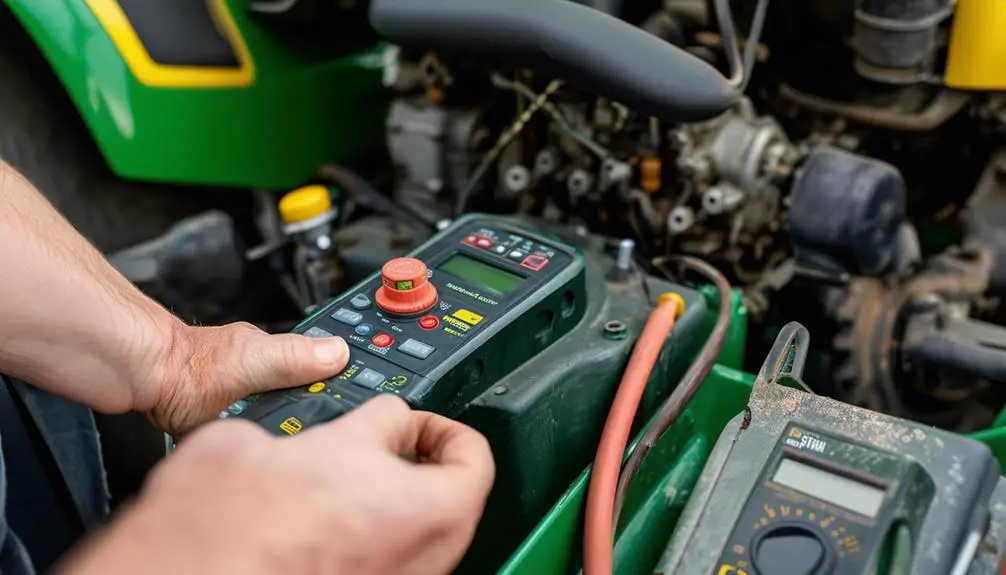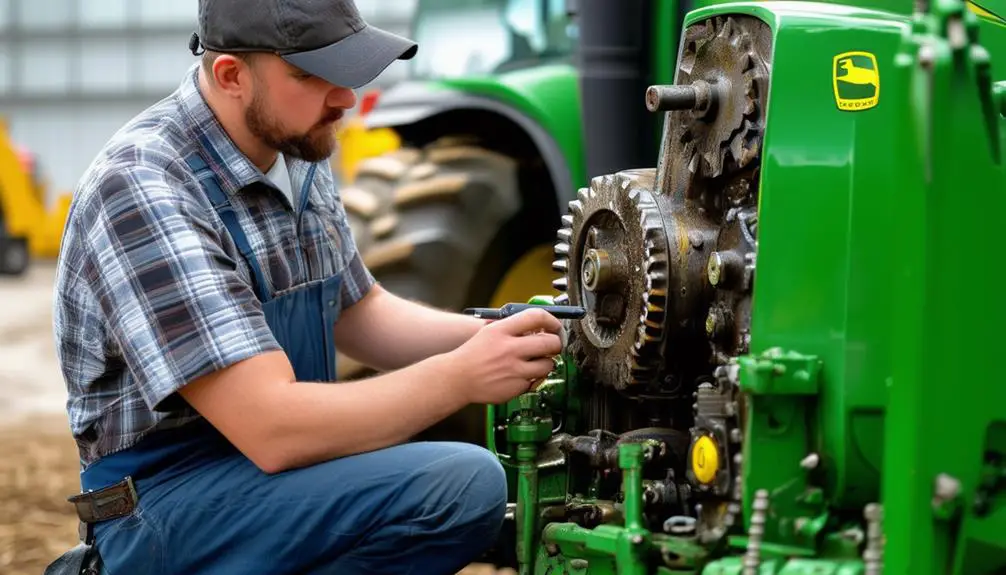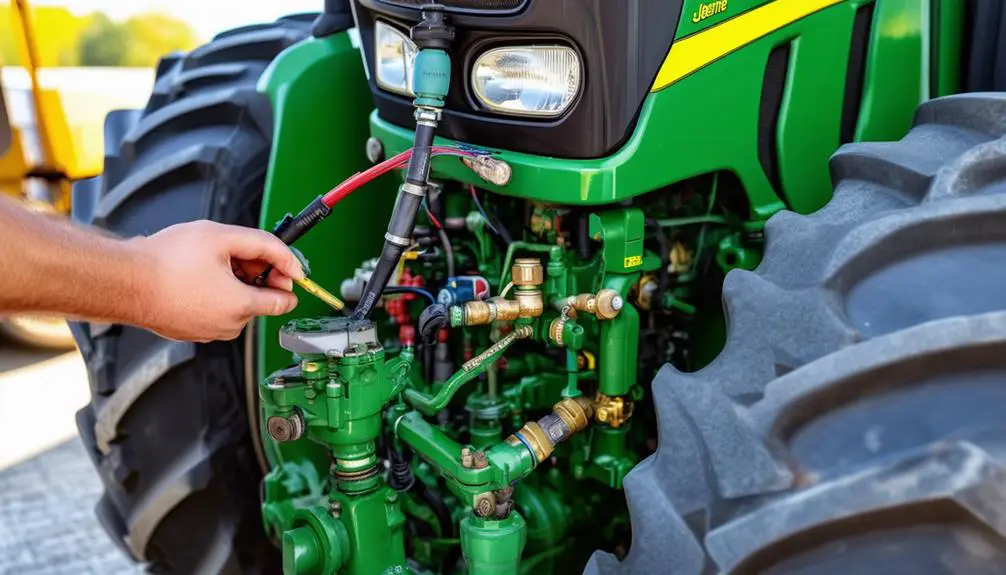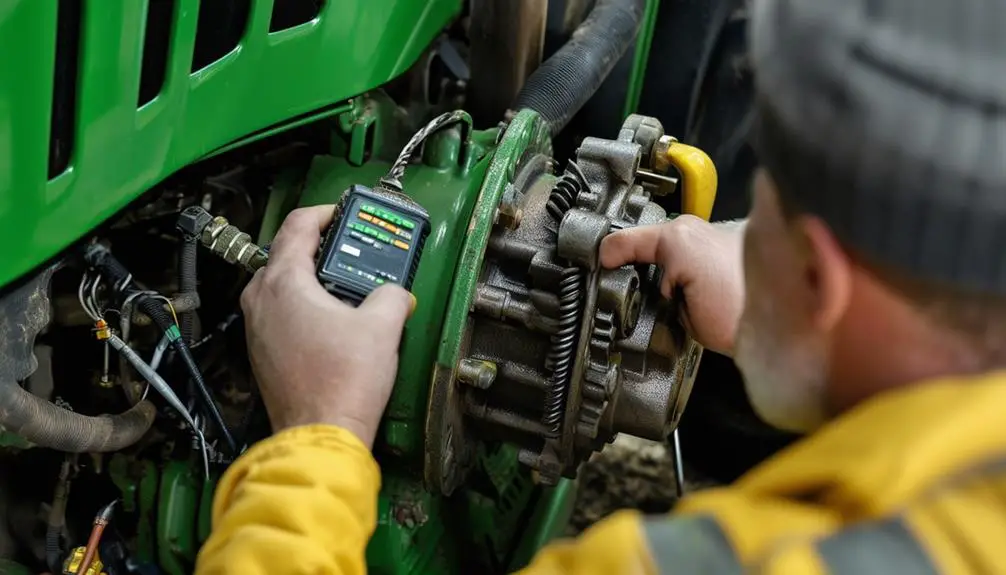When dealing with common issues on your John Deere 2010, addressing problems like engine starting difficulties, overheating concerns, and transmission malfunctions is vital. However, there's a particular area that often gets overlooked but can have a significant impact on the tractor's performance. By focusing on this pivotal component, you can guarantee smoother operations and avoid costly repairs down the line. Stay tuned to discover this essential element that could be causing more trouble than you realize.
Things to Note
- Check fuel system for clean supply and clogs.
- Inspect spark plugs for wear or dirt accumulation.
- Verify battery charge and electrical connections.
- Address transmission fluid leaks and clutch wear.
- Monitor coolant levels, radiator airflow, and thermostat function.
Engine Starting Issues

If your John Deere 2010 is frequently experiencing engine starting issues, there are several common reasons that may be causing this problem.
First, check the fuel system. Confirm that there's an ample supply of clean fuel reaching the engine. Sometimes, a clogged fuel filter or a faulty fuel pump can impede the flow of fuel, leading to starting difficulties.
Additionally, inspect the spark plugs. Worn-out or dirty spark plugs can prevent proper ignition, making it challenging for your engine to start smoothly.
Another potential culprit could be the battery. A weak or dead battery will struggle to provide the necessary power to start the engine. Make sure your battery is fully charged and in good condition.
Moreover, check the electrical connections to ensure they're tight and free of corrosion. Loose or corroded connections can disrupt the flow of electricity, affecting the starting process.
Overheating Problems
To address overheating problems with your John Deere 2010, focus on examining the cooling system for potential issues. Here are some steps to help you troubleshoot and resolve the overheating problem:
- Check Coolant Levels: Confirm that the coolant levels are adequate and there are no leaks in the system.
- Inspect Radiator: Look for any obstructions or debris blocking the radiator fins that may be impeding proper airflow.
- Test Thermostat: Verify if the thermostat is functioning correctly by testing it to see if it opens and closes as it should.
Taking these steps can often help alleviate overheating issues with your John Deere 2010. By regularly maintaining and inspecting the cooling system, you can guarantee that your tractor operates smoothly without any overheating interruptions.
Transmission Not Engaging

Inspect the transmission fluid levels and examine for any leaks to troubleshoot the issue of the transmission not engaging on your John Deere 2010. Low transmission fluid levels or leaks can prevent the transmission from functioning correctly. Verify the fluid is at the proper level and look for any signs of leakage around the transmission system.
If the fluid levels appear to be adequate and there are no leaks present, the issue may lie with the transmission linkage. Check that the linkage is properly connected and not damaged. Sometimes, a simple adjustment to the linkage can resolve the problem of the transmission not engaging.
Additionally, consider the possibility of a worn-out clutch or clutch plates. If the clutch is slipping or not fully engaging, it can lead to transmission issues. Inspect the clutch system and replace any worn-out components as necessary to confirm proper engagement of the transmission.
Electrical System Malfunctions
If you're experiencing electrical issues with your John Deere 2010, it's important to check for wiring problems first. You can diagnose these issues by inspecting the wiring harness for any visible damage or loose connections.
Additionally, remember to follow proper battery replacement tips to guarantee the electrical system functions correctly.
Wiring Issues Diagnosis
Wondering how to pinpoint wiring issues in your John Deere 2010 for effective diagnosis of electrical system malfunctions? To identify and resolve wiring problems efficiently, follow these steps:
- Visual Inspection: Start by visually examining the wiring harness for any signs of damage such as fraying, cuts, or exposed wires. Look for melted insulation or loose connections that could be causing electrical failures.
- Testing Continuity: Utilize a multimeter to test the continuity of wires. Check for any breaks in the wiring that could be disrupting the flow of electricity. Confirm all connections are secure and conducting electricity as intended.
- Voltage Testing: Perform voltage testing to verify that electricity is flowing correctly through the wiring system. Look out for any irregularities in voltage levels that could indicate a faulty wire or connection.
Battery Replacement Tips
When replacing the battery in your John Deere 2010 to address electrical system malfunctions, be sure to disconnect the negative terminal first to prevent any accidental short circuits. This simple step can save you from potential safety hazards and further damage to your tractor's electrical components.
Before installing the new battery, make certain that the terminals are clean and free of corrosion. A mixture of baking soda and water can help clean any buildup on the terminals. Additionally, inspect the battery cables for any signs of wear or fraying, as these can cause connectivity issues.
When connecting the new battery, start with the positive terminal first and then the negative terminal. Tighten the terminals securely to avoid loose connections that may lead to electrical problems.
Hydraulic System Troubles

You need to check for fluid leaks and address them promptly to prevent further damage to your John Deere 2010's hydraulic system.
If you suspect pump malfunction, it's vital to diagnose the issue accurately to determine the necessary repairs.
Understanding these points can help you maintain the efficiency and longevity of your equipment.
Fluid Leaks Identification
To identify hydraulic system fluid leaks on your John Deere 2010, start by inspecting the hoses and connections for any signs of damage or loose fittings. Look out for any oil puddles under the tractor or visible oil stains on the hoses.
Here are some tips to help you pinpoint and address fluid leaks:
- Check Hose Connections: Confirm all hose connections are tight and secure to prevent leaks.
- Inspect Hose Condition: Look for cracks, abrasions, or bulges on the hoses that may indicate a leak.
- Examine Hydraulic Fittings: Investigate the fittings for any signs of wear or damage that could be causing leaks.
Regularly monitoring and maintaining your hydraulic system can help prevent costly repairs and downtime. By staying proactive and addressing leaks promptly, you can keep your John Deere 2010 running smoothly and efficiently.
Pump Malfunction Diagnosis
Diagnosing pump malfunctions in the hydraulic system of your John Deere 2010 requires careful inspection and troubleshooting techniques. When experiencing issues such as slow or erratic operation of attachments, strange noises, or a complete loss of hydraulic power, it's essential to first check the hydraulic fluid level and quality. Low fluid levels or contamination can often be the root cause of pump problems.
Next, inspect the hydraulic lines and fittings for any signs of leaks or damage that could be affecting the pump's performance.
If everything appears to be in order externally, the next step is to test the pump pressure using a pressure gauge to determine if it falls within the manufacturer's specifications. A drop in pressure could indicate a failing pump that needs to be replaced.
Additionally, listening for unusual sounds coming from the pump while it's in operation can also provide valuable insights into its condition. By following these steps and conducting a thorough examination, you can effectively diagnose pump malfunctions in your John Deere 2010's hydraulic system and take appropriate action to resolve the issue.
Steering Difficulties
Experiencing resistance or sluggishness in the steering of your John Deere 2010 could indicate underlying issues that require attention. When faced with steering difficulties, it's important to address the problem promptly to make sure your equipment operates smoothly.
Here are some practical steps to troubleshoot steering issues:
- Check the Power Steering Fluid: Low power steering fluid levels can lead to poor steering performance. Make sure to inspect the fluid levels and top up if necessary.
- Inspect the Steering Linkage: Worn-out or damaged steering linkages can cause difficulties in steering. Check for any signs of wear and tear and replace as needed.
- Assess the Steering Gearbox: A malfunctioning steering gearbox can also result in steering problems. Inspect the gearbox for any issues and repair or replace it accordingly.
PTO Not Working Properly

Verify if the PTO on your John Deere 2010 is functioning correctly to guarantee best performance.
If the PTO isn't working properly, there are a few common issues you can check to resolve the problem.
First, inspect the PTO shaft for any signs of damage or wear. Make sure it's properly connected and not slipping.
Next, check the PTO clutch to see if it's engaging and disengaging smoothly. If there are any unusual noises or vibrations when engaging the PTO, it could indicate a problem with the clutch.
Additionally, confirm that the PTO hydraulic system has adequate fluid levels and there are no leaks in the system.
If all these components seem to be in working order, it might be necessary to consult a professional technician to diagnose any more complex issues with the PTO system.
Troubleshooting Miscellaneous Errors
Check for any unexpected errors that may arise while operating your John Deere 2010. Sometimes, miscellaneous issues can pop up, causing frustration and downtime. Here are some tips to help you troubleshoot these miscellaneous errors:
- Electrical Problems
- Verify all electrical connections are secure and free of corrosion.
- Examine the fuses and replace any that are blown.
- Test the battery to make sure it's holding a proper charge.
- Hydraulic System Concerns
- Inspect hydraulic lines for any leaks or damage.
- Verify the hydraulic fluid level and top up if necessary.
- Clean or replace the hydraulic filters if they're clogged.
- Engine Performance
- Monitor the engine temperature to prevent overheating.
- Check the air filter and replace if dirty.
- Inspect the spark plugs for signs of wear and replace if needed.
Frequently Asked Questions
Can I Use Regular Gasoline in a John Deere 2010?
Yes, you can use regular gasoline in a John Deere 2010. It's safe and won't cause any issues with the engine. Just make sure to follow the manufacturer's recommendations for fuel type and quality.
Using regular gasoline will keep your equipment running smoothly without any unnecessary complications. Enjoy the convenience and simplicity of using regular gasoline in your John Deere 2010.
How Often Should I Change the Air Filter on a John Deere 2010?
You should change the air filter on your John Deere 2010 at least once a year to maintain your engine running smoothly.
Regular maintenance like this can help prevent performance issues and extend the life of your equipment.
What Type of Oil Should I Use for the Engine in a John Deere 2010?
For the engine in a John Deere 2010, you should use the recommended oil type specified in the owner's manual. Opting for the correct oil will guarantee peak performance and longevity of your equipment.
Regularly checking and changing the oil as per the manufacturer's instructions is essential for maintaining the engine's health.
Always prioritize using high-quality oil to keep your John Deere running smoothly.
Is It Normal for a John Deere 2010 to Produce White Smoke?
Yes, it's normal for a John Deere 2010 to produce white smoke. This can happen due to various reasons such as condensation burning off or an overload of fuel.
Keep an eye on the smoke's color, consistency, and smell to determine if there's a more serious issue.
If you're ever concerned, it's always best to consult a professional for a thorough inspection and peace of mind.
How Do I Properly Store a John Deere 2010 During the Winter Months?
When winter blows in, shield your John Deere 2010 like a precious gem. Find a cozy spot free from harsh elements, where it can drift into hibernation peacefully.
Give it a good clean, drain any fluids that could freeze, and store it under a snug cover. Protect its heart, the engine, from the icy grip of winter.
Show your trusty steed the care it deserves for a smooth awakening come spring.
Conclusion
To sum up, by addressing common issues with the John Deere 2010 such as:
- engine starting problems,
- overheating issues,
- transmission not engaging,
- electrical system malfunctions,
- hydraulic system troubles,
- steering challenges, and
- PTO functionality,
you can guarantee your tractor runs smoothly and efficiently.
Remember to regularly inspect and maintain your tractor to prevent unforeseen breakdowns and keep it operating at its peak.
Happy troubleshooting!